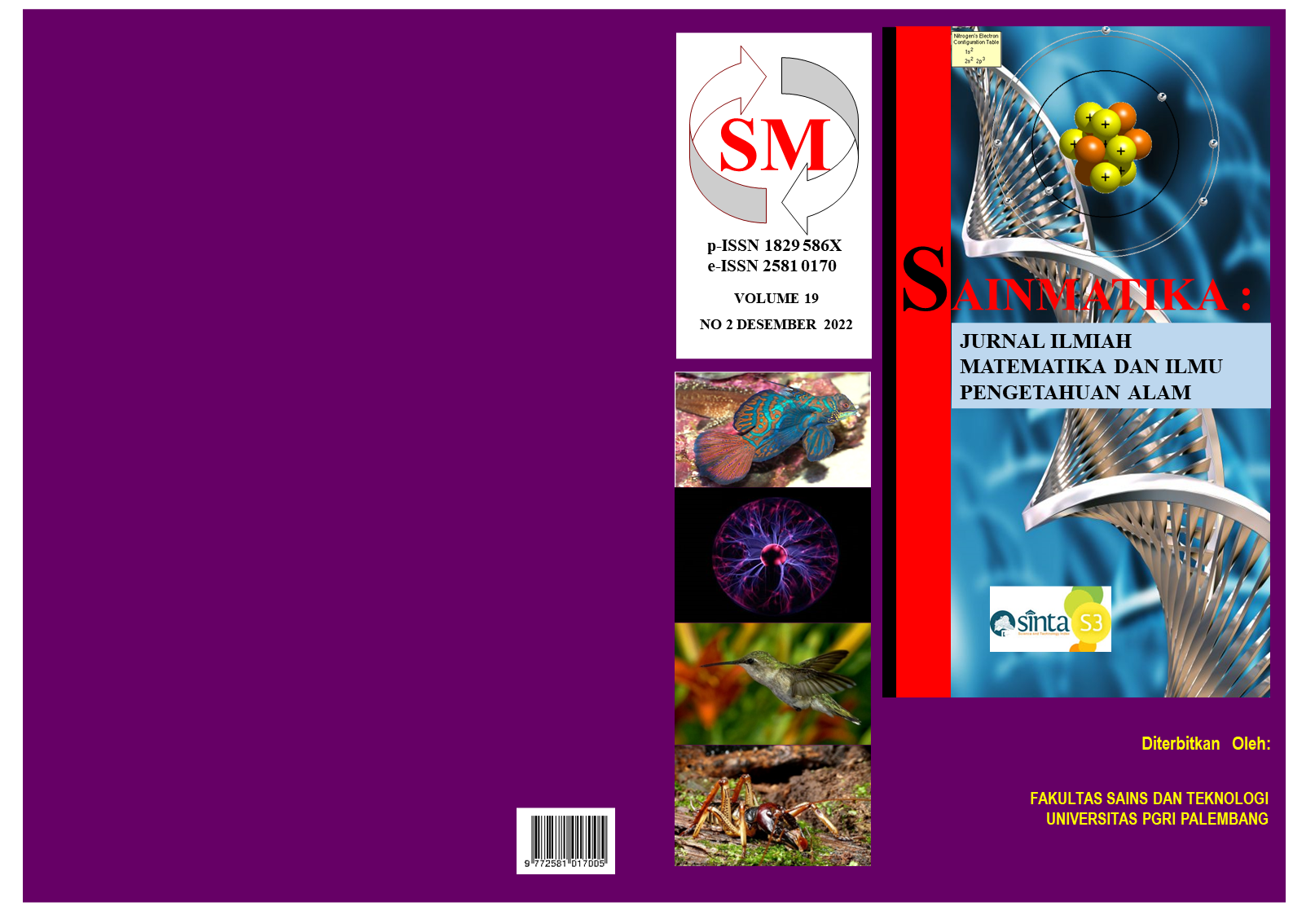Solution And Visualization 3D Plane Inverse Kinematics Method
DOI:
https://doi.org/10.31851/sainmatika.v19i2.9421Keywords:
Robot arm analiysis, hyper-redundant robot, Mathlab softwareAbstract
The hyper-redundant type of robot is a type of robot that in carrying out its duties in the field of kinematics its degrees of freedom exceed the required minimum degrees. The advantage will be increased capability in operation and performance, if the degrees of freedom are excessive, even in unorganized and complex systems and environments. Algebraic approach method in inverse kinematics algorithm analysis can use; analytic algebra, jacobian basis, analytic KI, exponential multiplication, grobner, and conformal geometry. Iterative approach method in inverse kinematics algorithm analysis can use; genetic algorithm, fuzzy logic, ANFIS, and evolutionary algorithm. The geometric approach method in the inverse kinematics algorithm analysis can use; capital method. The purpose of this study is to analyze a virtual 2 arm robot, which will use axis manipulation in three dimensions using an inverse kinematics solution, using a geometric approach. How to step along on the z axis by rotating and using the reverse kinematics solution to the desired location. The visualization results will be repeated so as to ensure the effectiveness of the algorithm. As for this algorithm will provide a single solution, and this algorithm will prevent and reduce singularities if the link is lower.
References
Albrecht-Buehler, C., Watson, B., & Shamma, D. A. (2005). Visualizing live text streams using motion and temporal pooling. IEEE Computer Graphics and Applications, 25(3), 52–59.
Almusawi, A. R., Dülger, L. C., & Kapucu, S. (2016). A new artificial neural network approach in solving inverse kinematics of robotic arm (denso vp6242). Computational Intelligence and Neuroscience, 2016.
Anakwe, R. E., Middleton, S. D., Jenkins, P. J., & McQueen, M. M. (2011). Patient-reported outcomes after simple dislocation of the elbow. JBJS, 93(13), 1220–1226.
Aristidou, A., Lasenby, J., Chrysanthou, Y., & Shamir, A. (2018). Inverse kinematics techniques in computer graphics: A survey. 37(6), 35–58.
Barnsley, L. C., Carugo, D., & Stride, E. (2016). Optimized shapes of magnetic arrays for drug targeting applications. Journal of Physics D: Applied Physics, 49(22), 225501.
Beeson, P., & Ames, B. (2015). TRAC-IK: An open-source library for improved solving of generic inverse kinematics. 928–935.
Biess, A., Liebermann, D. G., & Flash, T. (2007). A computational model for redundant human three-dimensional pointing movements: Integration of independent spatial and temporal motor plans simplifies movement dynamics. Journal of Neuroscience, 27(48), 13045–13064.
Bostan, A., Bousquet-Mélou, M., Kauers, M., & Melczer, S. (2016). On 3-dimensional lattice walks confined to the positive octant. Annals of Combinatorics, 20(4), 661–704.
Chen, H. (2007). Passive dynamic walking with knees: A point foot model.
Chirikjian, G. S., & Burdick, J. W. (1994). A hyper-redundant manipulator. IEEE Robotics & Automation Magazine, 1(4), 22–29.
Choi, C., Lee, K., Shin, K., Ahn, H., & Lee, K. (1997). Inverse kinematics of a reclaimer: Redundancy and solution. 3, 2883–2887.
Deb, K. (2003). Multi-objective evolutionary algorithms: Introducing bias among Pareto-optimal solutions. In Advances in evolutionary computing (pp. 263–292). Springer.
Faumont, S., Rondeau, G., Thiele, T. R., Lawton, K. J., McCormick, K. E., Sottile, M., Griesbeck, O., Heckscher, E. S., Roberts, W. M., & Doe, C. Q. (2011). An image-free opto-mechanical system for creating virtual environments and imaging neuronal activity in freely moving Caenorhabditis elegans. PloS One, 6(9), e24666.
Gandham, S., Dawande, M., & Prakash, R. (2008). Link scheduling in wireless sensor networks: Distributed edge-coloring revisited. Journal of Parallel and Distributed Computing, 68(8), 1122–1134.
Gu, X., Gortler, S. J., & Hoppe, H. (2002). Geometry images. 355–361.
Guo, S., Pan, S., Li, X., Shi, L., Zhang, P., Guo, P., & He, Y. (2017). A system on chip-based real-time tracking system for amphibious spherical robots. International Journal of Advanced Robotic Systems, 14(4), 1729881417716559.
Harbourne, R. T., & Stergiou, N. (2009). Movement variability and the use of nonlinear tools: Principles to guide physical therapist practice. Physical Therapy, 89(3), 267–282.
Hu, Q., & Sonnerup, B. U. (2002). Reconstruction of magnetic clouds in the solar wind: Orientations and configurations. Journal of Geophysical Research: Space Physics, 107(A7), SSH-10.
Knez, M., & Camerer, C. (1994). Creating expectational assets in the laboratory: Coordination in ‘weakestâ€link’games. Strategic Management Journal, 15(S1), 101–119.
Latash, M. L., & Gottlieb, G. L. (1991). Reconstruction of shifting elbow joint compliant characteristics during fast and slow movements. Neuroscience, 43(2–3), 697–712.
Latour, B. (1987). Science in action: How to follow scientists and engineers through society. Harvard university press.
Levy, A., & Lindenbaum, M. (1998). Sequential Karhunen-Loeve basis extraction and its application to images. 2, 456–460.
Li, Y., Ma, Y., Liu, S., Luo, Z., Mei, J., Huang, T., & Chetwynd, D. (2014). Integrated design of a 4-DOF high-speed pick-and-place parallel robot. CIRP Annals, 63(1), 185–188.
Lü, L., & Zhou, T. (2011). Link prediction in complex networks: A survey. Physica A: Statistical Mechanics and Its Applications, 390(6), 1150–1170.
Manseur, R., & Doty, K. L. (1988). A fast algorithm for inverse kinematic analysis of robot manipulators. The International Journal of Robotics Research, 7(3), 52–63.
Mattos, D., Latash, M. L., Park, E., Kuhl, J., & Scholz, J. (2011). Unpredictable elbow joint perturbation during reaching results in multijoint motor equivalence. Journal of Neurophysiology, 106(3), 1424–1436.
McCormick, S. U., & Drew, S. J. (2011). Virtual model surgery for efficient planning and surgical performance. Journal of Oral and Maxillofacial Surgery, 69(3), 638–644.
Merad, M., de Montalivet, E., Legrand, M., Mastinu, E., Ortiz-Catalan, M., Touillet, A., Martinet, N., Paysant, J., Roby-Brami, A., & Jarrasse, N. (2020). Assessment of an automatic prosthetic elbow control strategy using residual limb motion for transhumeral amputated individuals with socket or osseointegrated prostheses. IEEE Transactions on Medical Robotics and Bionics, 2(1), 38–49.
Mohamed, H. A., Yahya, S., Moghavvemi, M., & Yang, S. (2009). A new inverse kinematics method for three dimensional redundant manipulators. 1557–1562.
Nearchou, A. C. (1998). Solving the inverse kinematics problem of redundant robots operating in complex environments via a modified genetic algorithm. Mechanism and Machine Theory, 33(3), 273–292.
Noor, N. M., Pett, S. L., Esmail, H., Crook, A. M., Vale, C. L., Sydes, M. R., & Parmar, M. K. (2020). Adaptive platform trials using multi-arm, multi-stage protocols: Getting fast answers in pandemic settings. F1000Research, 9.
Parrilo, P. A. (2003). Semidefinite programming relaxations for semialgebraic problems. Mathematical Programming, 96(2), 293–320.
Pierrot, F., Dombre, E., Dégoulange, E., Urbain, L., Caron, P., Boudet, S., Gariépy, J., & Mégnien, J.-L. (1999). Hippocrate: A safe robot arm for medical applications with force feedback. Medical Image Analysis, 3(3), 285–300.
Pinker, S., & Finke, R. A. (1980). Emergent two-dimensional patterns in images rotated in depth. Journal of Experimental Psychology: Human Perception and Performance, 6(2), 244.
Rosheim, M. E. (1994). Robot evolution: The development of anthrobotics. John Wiley & Sons.
Samarakoon, S., Muthugala, M., & Elara, M. R. (2021). Toward obstacle-specific morphology for a reconfigurable tiling robot. Journal of Ambient Intelligence and Humanized Computing, 1–13.
Serrezuela, R. R., Chavarro, A. F. C., Cardozo, M. A. T., Toquica, A. L., & Martinez, L. F. O. (2017). Kinematic modelling of a robotic arm manipulator using Matlab. ARPN Journal of Engineering and Applied Sciences, 12(7), 2037–2045.
Sessler, G. M., & Jondral, F. K. (2005). Low complexity polynomial expansion multiuser detector for CDMA systems. IEEE Transactions on Vehicular Technology, 54(4), 1379–1391.
Sørby, K. (2007). Inverse kinematics of five-axis machines near singular configurations. International Journal of Machine Tools and Manufacture, 47(2), 299–306.
Strom, J., Slavov, G., & Chown, E. (2009). Omnidirectional walking using zmp and preview control for the nao humanoid robot. 378–389.
Tejomurtula, S., & Kak, S. (1999). Inverse kinematics in robotics using neural networks. Information Sciences, 116(2–4), 147–164.
Tunwannarux, A. (2007). Design of a 5-Joint Mechanical Arm with User-Friendly Control Program. UTCC Engineering Research Papers.
Tutsoy, O., Erol Barkana, D., & Colak, S. (2017). Learning to balance an NAO robot using reinforcement learning with symbolic inverse kinematic. Transactions of the Institute of Measurement and Control, 39(11), 1735–1748.
UE, C. (n.d.). SRM ARTS AND SCIENCE COLLEGE. Artificial Intelligence, 4(25), 75–100.
Van Der Vleuten, C. P. (1996). The assessment of professional competence: Developments, research and practical implications. Advances in Health Sciences Education, 1(1), 41–67.
Vincze, M., Prenninger, J., & Gander, H. (1994). A laser tracking system to measure position and orientation of robot end effectors under motion. The International Journal of Robotics Research, 13(4), 305–314.
Wei, Y., Jian, S., He, S., & Wang, Z. (2014). General approach for inverse kinematics of nR robots. Mechanism and Machine Theory, 75, 97–106.
Woods, R. P., Mazziotta, J. C., & Cherry, S. R. (1993). MRI-PET registration with automated algorithm. Journal of Computer Assisted Tomography, 17, 536–536.
Yang, B., Yih, W., He, X., Gao, J., & Deng, L. (2014). Embedding entities and relations for learning and inference in knowledge bases. ArXiv Preprint ArXiv:1412.6575.
Yang, H., Xie, Z., Sun, K., Zhao, X., Jin, M., & Li, C. (2015). Development of ground experiment system for space end-effector capturing the floating target in 3-dimensional space. Industrial Robot: An International Journal.
Yu, G., Upadhyaya, P., Fan, Y., Alzate, J. G., Jiang, W., Wong, K. L., Takei, S., Bender, S. A., Chang, L.-T., & Jiang, Y. (2014). Switching of perpendicular magnetization by spin–orbit torques in the absence of external magnetic fields. Nature Nanotechnology, 9(7), 548–554.
Zamanzadeh, A., & Ahmadi, H. (2021). Inverse kinematic of European Robotic Arm based on a new geometrical approach. AUT Journal of Mechanical Engineering, 5(1), 13–48.
Zang, H., Jue, J. P., & Mukherjee, B. (2000). A review of routing and wavelength assignment approaches for wavelength-routed optical WDM networks. Optical Networks Magazine, 1(1), 47–60.









